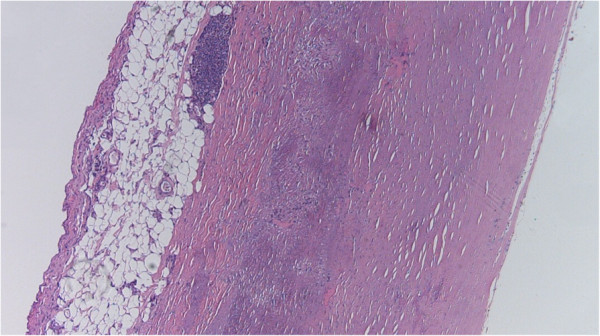Playlist
Show Playlist
Hide Playlist
Atherosclerosis: Pathophysiology
-
Slides Acute and Chronic Inflammation Complications of healing.pdf
-
Reference List Pathology.pdf
-
Download Lecture Overview
00:00 Okay, another kind of general thing. 00:04 So, by way of a summary, wound healing is a very stereotyped response to injury. 00:11 You get tissue injury, we get our initial inflammatory cell recruitment and activation. 00:19 They elaborate cytokines and growth factors. 00:21 We get angiogenesis, if we can't restore normal function, we form scar, starting with angiogenesis. 00:29 We get proliferation of the fibroblasts that are going to lay down more matrix. 00:35 And we remodel that matrix. 00:38 And this is what happens when we can't regenerate. 00:42 Obviously, if we can regenerate, we get complete renewal, we don't have those last three steps. 00:47 Okay, that stereotype response actually happens over, and over, and over again, in different disguises throughout the body. 00:56 This is, by way of an early introduction. 00:59 In a subsequent set of topics that we're going to share together can't wait. 01:05 We're gonna talk about atherosclerosis, which is a major form of human disease. 01:09 50% of the people listening to me, will die as a result of atherosclerosis. 01:15 Whoa, and any of that. 01:18 The point here is a little bit of an appetizer for the main course that will do much later, is that atherosclerosis is actually fundamentally response to vascular injury or vascular wounding. 01:30 And that's what atherosclerosis is. 01:32 It's the healing response in a blood vessel. 01:36 It's the same process. It's exactly the same process. 01:39 So there's not anything particularly new to learn about atherosclerosis except some of the names. 01:44 So in any event, we have some initial injury. 01:47 That initial injury are the risk factors. 01:50 Can be infection, but it's hypertension, it's smoking, it's diabetes, it's hypercholesterolemia, there can be genetic factors. 01:56 There can be inflammation, that's the tissue injury. 02:00 And then we recruit in because of tissue injury, inflammatory cells, lymphocytes and macrophages. 02:05 And they get activated. 02:06 And they're making chemokines and huge molecules, and they're making interferon gamma. 02:10 They're doing all the things that we've talked about. 02:14 They are also elaborating interleukin-1 and TNF, the macrophages in particular, which will drive the recruitment and activation of smooth muscle cells that live in the media, and will drive angiogenesis. 02:26 So we will get everything we've talked about and wound healing going on in this vessel wall. 02:32 With cellular proliferation, coming from a variety of other factors, TGF-beta other things, we will get now the smooth muscle cells that had been recruited to proliferate, and we get a progressive increase in plaque formation. 02:49 It's just the vessel responding to injury. 02:52 It will make more matrix. 02:54 So we'll get a lot more collagen that's in there. 02:57 Again, driven by the same factors we've been talking about. 03:00 And that matrix, it remodels. 03:03 And when remodels with matrix metalloproteinases, we can get a plaque rupture, and we get a plaque rupture and then we get a thrombus. 03:10 And that's an acute heart attack right there happening if this is a coronary artery. 03:15 So this is an appetizer again for the main course that we'll talk about later. 03:18 But basically, atherosclerosis is just response of the vessel wall to injury. 03:26 Here's what it looks like histologically. 03:28 This is a coronary artery, and you're looking at the cause of death in this patient. 03:34 The darker pink rim kind of all the way around at the periphery of that is smooth muscle media. 03:41 Everything that's inside of that, that looks kind of blue and different colors, that's atherosclerotic plaque. 03:50 And then that pink thing in the middle is where the plaque ruptured, and we have an acute thrombus. 03:57 So you're looking at the cause of death, but we're basically looking at 20 years, 30 years of vessel wall injury, and normal wound healing in a vessel.
About the Lecture
The lecture Atherosclerosis: Pathophysiology by Richard Mitchell, MD, PhD is from the course Acute and Chronic Inflammation.
Included Quiz Questions
Which of the following enzymes is responsible for matrix remodelling?
- Matrix metalloproteinase (MMP)
- Lipase
- Hydrogen peroxidase
- Amylase
- Hyaluronidase
Which of the following cytokines is responsible for the recruitment of smooth muscle cells in atherosclerosis?
- Tumor necrosis factor-alpha (TNF-α)
- IL-5
- IL-8
- IL-6
- Interferon-gamma (IFN-γ)
Customer reviews
5,0 of 5 stars
| 5 Stars |
|
5 |
| 4 Stars |
|
0 |
| 3 Stars |
|
0 |
| 2 Stars |
|
0 |
| 1 Star |
|
0 |




